

|
 |

Home / Product Reviews
September 2006
Gourmet News & Views
Trends, Products & Items of Note In The World Of Specialty Foods
Click here to return to the current month’s news
You can receive the news via RSS by clicking on the RSS box above
9.25.06
News
Holy Tomato. Fans of the lovely red fruit will be facing sticker shock. Blistering summer heat in California and hurricanes in Florida and Mexico’s Baja region have shriveled tomato yields by as much as 40%. Cauliflower, celery and carrots also were hammered by the summer heat wave. At this time last year, according to an article in the Sacramento Bee, the wholesale price for a 25-pound box of tomatoes was in the $13 to $16 range. Today, it’s between $30 and $40. Produce wholesalers expect short supplies at least through mid-October. What’s a vegetable-lover to do? For salads, sandwiches and burgers, try substituting roasted red peppers. You can buy imported sun-dried tomatoes in bulk and marinate them in olive oil, an equally tasty and potentially more cost-effective solution. For pasta, try pesto, or simply toss pasta with olive oil or butter and parmesan. Better yet, check your cookbooks: the first documented tomato sauce recipe is from 1839, because Europeans felt the tomato, a New World plant, was poisonous, and grew it as a houseplant. Prior to then, all sauces were tomato-free.
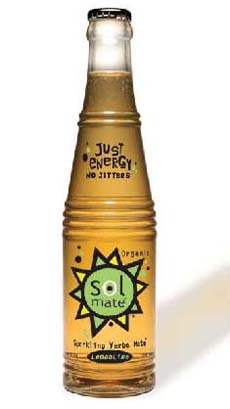 Product Watch Product Watch
Sol Maté Organic Energy Drink. With increasing demands for both energy beverages and organic foods, Sol Maté has launched, providing the verve without the jitters. Looking like ginger ale but with a more sophisticated flavor—exotic yet enjoyable—the all-natural sparkling drink is based on yerba maté, a South American holly bush long celebrated for its healthy and stimulating properties. Yerba maté contains naturally-occurring caffeine plus theobromine, a known mood elevator also found in chocolate. The two compounds combine to provide a sustainable, longer lasting lift. The craft-brewed beverage is high in vitamins and minerals and is rich in antioxidants. At 90 calories per bottle, it is more than one-third lower in carbohydrates and sugar than regular sodas. It is currently available in Original and Lemon Lime flavors. Read our full product review.
Biodynamic® Wines. Wild Oats Markets, a leading national natural and organic foods retailer, announced it will add Certified Biodynamic wines and wines made with Biodynamic grapes to its selection of organic wines. Biodynamic® agriculture is characterized by a connection with the soil, sunlight and rhythms of nature that are unique to each vineyard. Certified Biodynamic wines are made without the addition of yeast, enzymes, tannins, oak or chapitalization, which manipulates the wine.  Vineyards that practice biodynamic agriculture include Ceago, Cooper Mountain, Frey and Patianna. Their wines are available now in all Wild Oats stores that have liquor licenses. Biodynamic agriculture dates back to 1924, is considered the oldest comprehensive method of farming and is practiced around the world. A more rigorous process than organic farming, it sustains soil productivity and maintains biodiversity with the use of organic pest controls, crop rotation and the cyclical rhythms of nature. Practitioners attest that biodynamic agriculture results in a greener planet, self-sustaining farms, healthier soil, and great-tasting food and wines that are rich in nutrients. In order for a product to be labeled as Biodynamic, it must comply with strict standards set by Demeter USA (demeter-usa.org). Biodynamic® is a registered trademark held by Demeter Association Inc. (see certification seal above) and is globally recognized as a symbol for products grown using approved Biodynamic methods. Read our complete article on biodynamic versus organic farming. Vineyards that practice biodynamic agriculture include Ceago, Cooper Mountain, Frey and Patianna. Their wines are available now in all Wild Oats stores that have liquor licenses. Biodynamic agriculture dates back to 1924, is considered the oldest comprehensive method of farming and is practiced around the world. A more rigorous process than organic farming, it sustains soil productivity and maintains biodiversity with the use of organic pest controls, crop rotation and the cyclical rhythms of nature. Practitioners attest that biodynamic agriculture results in a greener planet, self-sustaining farms, healthier soil, and great-tasting food and wines that are rich in nutrients. In order for a product to be labeled as Biodynamic, it must comply with strict standards set by Demeter USA (demeter-usa.org). Biodynamic® is a registered trademark held by Demeter Association Inc. (see certification seal above) and is globally recognized as a symbol for products grown using approved Biodynamic methods. Read our complete article on biodynamic versus organic farming.
Lipton Follows Specialty Tea Packaging. As more people drink tea for its antioxidant qualities, they pay more attention to the tea they drink. The specialty tea business is booming. Now, the world’s largest tea brand, Lipton®, has gotten into the specialty act, launching a new line of premium, long-leaf teas. Lipton® Pyramid Teas 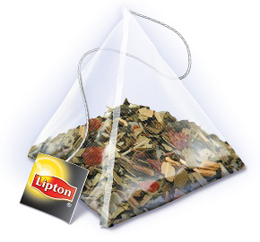 are packaged in pyramid-shaped, gossamer tea bags, similar to those that have been used for several years by specialty tea producers. Launching with Vanilla Caramel Truffle, Island Mango and Bavarian Wild Berry mixed with black, white, green and red teas, each flavor of Lipton® Pyramid Teas blends long leaf tea, real pieces of fruit, herbs and other natural flavors. Lipton® Pyramid Teas are available nationwide with a suggested retail price of $3.49 for a 20-count box, higher than Twinings and other premium-priced supermarket teas (that are not in fancy bags), but less than specialty store brands. It is the first premium tea of its kind offered in mass-market retail and grocery stores. While the company is marketing the product as “revolutionary,” the revolution was begun five years ago by specialty tea producers like Mighty Leaf and Tea Forte (and numerous other since), which have been producing a similar-shaped bag and loose leaf tea blends (below, Tea Forte’s pyramid-shaped tea bag). However, given its mammoth size, Lipton is in a position to sell more Pyramid Tea bags than the entire specialty food industry. This gives way to the second point: long leaf tea doesn’t mean top quality tea, any more than 70% cacao chocolate means great chocolate, a point we’ve previously noted in this column. The finest leaves come from very small estates that could never supply enough tea to meet the need of a mass marketer like Lipton. Still, the tea is a step up from the regular Lipton bag tea—at a step up in price, as well. are packaged in pyramid-shaped, gossamer tea bags, similar to those that have been used for several years by specialty tea producers. Launching with Vanilla Caramel Truffle, Island Mango and Bavarian Wild Berry mixed with black, white, green and red teas, each flavor of Lipton® Pyramid Teas blends long leaf tea, real pieces of fruit, herbs and other natural flavors. Lipton® Pyramid Teas are available nationwide with a suggested retail price of $3.49 for a 20-count box, higher than Twinings and other premium-priced supermarket teas (that are not in fancy bags), but less than specialty store brands. It is the first premium tea of its kind offered in mass-market retail and grocery stores. While the company is marketing the product as “revolutionary,” the revolution was begun five years ago by specialty tea producers like Mighty Leaf and Tea Forte (and numerous other since), which have been producing a similar-shaped bag and loose leaf tea blends (below, Tea Forte’s pyramid-shaped tea bag). However, given its mammoth size, Lipton is in a position to sell more Pyramid Tea bags than the entire specialty food industry. This gives way to the second point: long leaf tea doesn’t mean top quality tea, any more than 70% cacao chocolate means great chocolate, a point we’ve previously noted in this column. The finest leaves come from very small estates that could never supply enough tea to meet the need of a mass marketer like Lipton. Still, the tea is a step up from the regular Lipton bag tea—at a step up in price, as well.
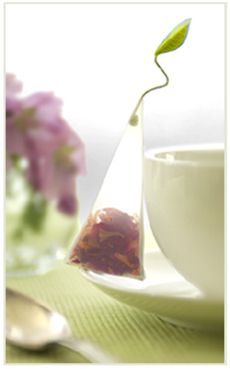 |
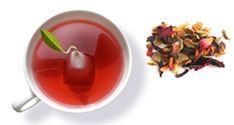
Tea Forte (photos above and left) is one of
several specialty tea producers that have
been selling silken and/or pyramid-shaped tea
bags for several years. |
9.18.06
Trends
Juice Box For Junior, Miniwine Box For You. When you don’t want pop the cork on a full bottle, the new solution is miniwine, also known as wine in a pouch or a mini 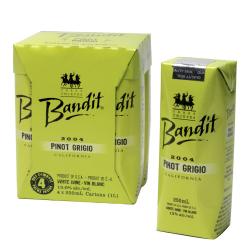 box. Borrowing a good idea from milk and juice boxes, these portion-controlled and portable formats combine form and function in attractive packaging. And they can go places that smaller glass bottles can’t—to the beach and the golf course, for example. While Diamond Creek and Chalone won’t be boxing their wines anytime soon, popular-priced winemakers, recognizing a growing demand by consumers for convenience. More mini bottles, cans and, most recently, juice-boxlike pouches that hold a single serving of wine are making it onto the shelves of supermarkets and other retailers. The pouches typically hold the contents of a glass (187 ml) or a glass and a half (250 ml) and are sold in four-packs. Inexpensive wines like Sutter Home and the colorfully-named Three Bandits, a sister company that sells its products only in jug, box or pouch, are at the forefront. Even Target has a chic designed version called the Cube. A four-pack costs typically costs $8 to $10. According to market research firm ACNielsen, sales of single-serving wines in 187-ml containers grew 14.7%, or $13 million, in the past year, pulling in nearly $100 million for the industry. During the same period, sales of standard-size 750-ml bottles grew 12%, and overall wine sales, 9%. As the single-serve format gains traction, the quality of single-serve wine eventually will improve—and perhaps a straw will be included, so there’s no need for a glass? box. Borrowing a good idea from milk and juice boxes, these portion-controlled and portable formats combine form and function in attractive packaging. And they can go places that smaller glass bottles can’t—to the beach and the golf course, for example. While Diamond Creek and Chalone won’t be boxing their wines anytime soon, popular-priced winemakers, recognizing a growing demand by consumers for convenience. More mini bottles, cans and, most recently, juice-boxlike pouches that hold a single serving of wine are making it onto the shelves of supermarkets and other retailers. The pouches typically hold the contents of a glass (187 ml) or a glass and a half (250 ml) and are sold in four-packs. Inexpensive wines like Sutter Home and the colorfully-named Three Bandits, a sister company that sells its products only in jug, box or pouch, are at the forefront. Even Target has a chic designed version called the Cube. A four-pack costs typically costs $8 to $10. According to market research firm ACNielsen, sales of single-serving wines in 187-ml containers grew 14.7%, or $13 million, in the past year, pulling in nearly $100 million for the industry. During the same period, sales of standard-size 750-ml bottles grew 12%, and overall wine sales, 9%. As the single-serve format gains traction, the quality of single-serve wine eventually will improve—and perhaps a straw will be included, so there’s no need for a glass?
Photo of Three Thieves Pinot Grigio Pouch and Four-Pack (PHOTO)
Product Watch
Vintage Sorbet. Wine Cellar Sorbets has launched the first-ever line of wine-based sorbets. The sorbets not simply wine-flavored, but are made almost entirely of wines 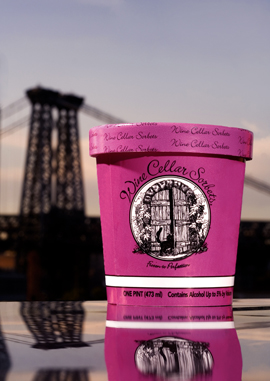 from around the world. (The package announces one must be of legal age to buy the sorbet, and in fact, the register scan told the cashier to verify our age!) Seven “current vintages” include three reds (a 2005 Cabernet Sauvignon from California, a 2004 Red Zinfandel from California, and a 2005 Pinot Noir from New York), three whites (a 2004 Riesling from New York, a non-vintage Sauternes from New York and a non-vintage Champagne from California), and one blush wine, a non-vintage May Wine from New York. The flavors will change on a rotating basis. Unlike most sorbets, these are not particularly sweet, but are serious gourmet products that make excellent palate cleansers between courses as well as sophisticated desserts. We would serve them with cheese. They also can be incorporated into frozen cocktails. Like most sorbets, they are low in sugar and have with no fat. They’re currently available in New York and New Jersey at Whole Foods Markets and specialty food stores, priced at $4.99 to $6.99 per pint. National distribution is planned. Check the store locator at WineCellarSorbets.com. from around the world. (The package announces one must be of legal age to buy the sorbet, and in fact, the register scan told the cashier to verify our age!) Seven “current vintages” include three reds (a 2005 Cabernet Sauvignon from California, a 2004 Red Zinfandel from California, and a 2005 Pinot Noir from New York), three whites (a 2004 Riesling from New York, a non-vintage Sauternes from New York and a non-vintage Champagne from California), and one blush wine, a non-vintage May Wine from New York. The flavors will change on a rotating basis. Unlike most sorbets, these are not particularly sweet, but are serious gourmet products that make excellent palate cleansers between courses as well as sophisticated desserts. We would serve them with cheese. They also can be incorporated into frozen cocktails. Like most sorbets, they are low in sugar and have with no fat. They’re currently available in New York and New Jersey at Whole Foods Markets and specialty food stores, priced at $4.99 to $6.99 per pint. National distribution is planned. Check the store locator at WineCellarSorbets.com.
Pom, Pom & More Pom. Creative chefs at fine restaurants have long used a sprinkling of pomegranate seeds (called arils) to garnish salads, main courses, desserts and sauces. But three years ago, most Americans had no idea what a pomegranate was. Now there’s a profusion of pomegranate: there were 290 pomegranate-flavored products at the 2006 Fancy Food Show in July, compared with 130 products at the 2005 show. Ever since POM Wonderful®, the California-based pomegranate grower, introduced its fruit juice to supermarkets in 2002 (and an pomegranate-iced tea line this past June), the exotic fruit has become ubiquitous: you can go into your local supermarket and buy the juice, the ice cream, the salad dressing, the cocktail mix, the lollipop, the nutrition 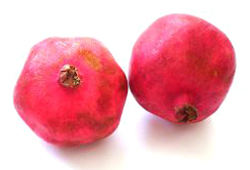 bar, even the gum. While other specialty juice companies were quick to “go pomegranate,” juice giant Tropicana® launched a pomegranate-blueberry juice in July. Native to the Middle East, the pomegranate is full of vitamins A, C and E and high in folic acid and polyphenol antioxidants. A study released by UCLA in June indicates that drinking a glass of pomegranate juice a day can help slow the spread of prostate cancer. The study also explains that, unlike drinking most fruit juices, drinking pomegranate juice is more healthful than eating the fruit itself because 70% of the antioxidants are released from the peel when the pomegranate is squeezed. (We’re not sure how healthy it is when we’re packing away a pint of our favorite product, the pomegranate ice cream with chocolate chips from Sheer Bliss). bar, even the gum. While other specialty juice companies were quick to “go pomegranate,” juice giant Tropicana® launched a pomegranate-blueberry juice in July. Native to the Middle East, the pomegranate is full of vitamins A, C and E and high in folic acid and polyphenol antioxidants. A study released by UCLA in June indicates that drinking a glass of pomegranate juice a day can help slow the spread of prostate cancer. The study also explains that, unlike drinking most fruit juices, drinking pomegranate juice is more healthful than eating the fruit itself because 70% of the antioxidants are released from the peel when the pomegranate is squeezed. (We’re not sure how healthy it is when we’re packing away a pint of our favorite product, the pomegranate ice cream with chocolate chips from Sheer Bliss).
Barley Tea: The Next Chai? Following yet another trend, ten years ago few Americans knew what chai was. Now, every brand of specialty tea seems to have a chai blend, and coffee chains sell chai lattes. Hoping Americans will continue to hunger for the new and exotic, Dakota Farms International Ltd., a South Dakota barley-grower, is trying to make barley tea, popular in Japan for centuries, a food trend here as well. The company already 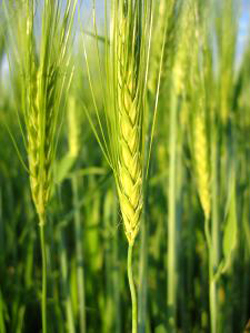 produces barley tea bags for a Japanese company, and will debut its American brand in a few months. Barley tea is made from grain, not tea leaves. It has an exotic roasted flavor: the grains are roasted as if they were coffee beans, then ground like coffee. In fact, the product tastes a bit like coffee, and can be drunk black or sweetened. Barley tea is naturally caffeine-free, high in fiber and contains antioxidants. In Japan, the tea is drunk hot or iced, and is as ubiquitous as soda, sold in vending machines and convenience stores. In America, according to the National Barley Foods Council, more than half of the nearly 320 million bushels of barley produced in the U.S. each year are used for animal feed. About 44% is used to produce malt, the key ingredient in another favorite beverage, beer. Only 2% is used in food products. However, as Americans seem to respond well to each new healthy food with a promise that hits the market, that number could grow. The U.S. Food and Drug Administration has approved the Council’s claim that barley can reduce the risk of coronary disease. Barley contains beta glucan, a fiber-type complex sugar that can help lower cholesterol. It remains for the tea-producers to prove how much cholesterol-lowering beta glucan remains in the barley after roasting. Barley tea can currently be found in Asian products stores and health food stores. Photo of barley by Carsten Müller. produces barley tea bags for a Japanese company, and will debut its American brand in a few months. Barley tea is made from grain, not tea leaves. It has an exotic roasted flavor: the grains are roasted as if they were coffee beans, then ground like coffee. In fact, the product tastes a bit like coffee, and can be drunk black or sweetened. Barley tea is naturally caffeine-free, high in fiber and contains antioxidants. In Japan, the tea is drunk hot or iced, and is as ubiquitous as soda, sold in vending machines and convenience stores. In America, according to the National Barley Foods Council, more than half of the nearly 320 million bushels of barley produced in the U.S. each year are used for animal feed. About 44% is used to produce malt, the key ingredient in another favorite beverage, beer. Only 2% is used in food products. However, as Americans seem to respond well to each new healthy food with a promise that hits the market, that number could grow. The U.S. Food and Drug Administration has approved the Council’s claim that barley can reduce the risk of coronary disease. Barley contains beta glucan, a fiber-type complex sugar that can help lower cholesterol. It remains for the tea-producers to prove how much cholesterol-lowering beta glucan remains in the barley after roasting. Barley tea can currently be found in Asian products stores and health food stores. Photo of barley by Carsten Müller.
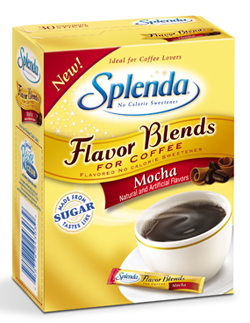 Diet Delight: SPLENDA® Flavor Blends For Coffee. More than 80% of Americans drink coffee daily¹, with flavors, like hazelnut, representing 30% of all specialty coffee sales². Combining flavors with its no-calorie sweetener, McNeil Nutritionals, makers of SPLENDA® Sweeteners, has launched SPLENDA® Flavor Blends for Coffee. Made specifically for hot coffee, the flavored sweetener is available in French Vanilla, Hazelnut and Mocha. The product is available at supermarkets nationwide and can be found in the coffee aisle. In November, SPLENDA® will launch another new product: SPLENDA® Cafe Sticks, previously available only in fine restaurants, will be available for at-home purchase. It’s the same sweetener as in the original flat yellow packages, but more upscale packaging. For more information, visit SPLENDA.com. Diet Delight: SPLENDA® Flavor Blends For Coffee. More than 80% of Americans drink coffee daily¹, with flavors, like hazelnut, representing 30% of all specialty coffee sales². Combining flavors with its no-calorie sweetener, McNeil Nutritionals, makers of SPLENDA® Sweeteners, has launched SPLENDA® Flavor Blends for Coffee. Made specifically for hot coffee, the flavored sweetener is available in French Vanilla, Hazelnut and Mocha. The product is available at supermarkets nationwide and can be found in the coffee aisle. In November, SPLENDA® will launch another new product: SPLENDA® Cafe Sticks, previously available only in fine restaurants, will be available for at-home purchase. It’s the same sweetener as in the original flat yellow packages, but more upscale packaging. For more information, visit SPLENDA.com.
¹According to a survey by the National Coffee Association of USA Survey, March 2006
²Gourmet Retailers Annual Survey, Tea & Coffee Trade Journal, February 2006

9.11.06
Trends
Belly Up To The Vinegar Bar. First there was the coffee bar. Then, briefly, the 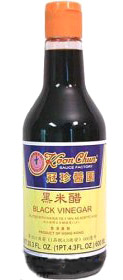 oxygen bar. Will the vinegar bar be next? As reported by Web Japan, it’s an incipient trend in Tokyo, as more and more consumers embrace the health benefits of rice vinegar. Vinegar bars and cafés have begun to smoothie-type beverages that combine rice vinegar with ingredients like fruits and vegetables (think vinegar, soy milk and blood orange juice or blueberry and vinegar shake). Vinegar, which is more than 10,000 years old, has been drunk for health since ancient times. Hippocrates prescribed a watered-down vinegar drink to his patients; Caesar’s army, drank it as a preventative medicine. In modern times, vinegar-drinking has long been popular among health faddists. The Japanese trend gained momentum in 2004, when kurozu, black vinegar, went mainstream. Chinese black vinegar contains more natural amino acids than regular vinegar. Kurozu is naturally fermented from rice; real kurozu is fermented in clay pots and has a smoky flavor. Want to try it yourself? You can buy black vinegar and mix your own. oxygen bar. Will the vinegar bar be next? As reported by Web Japan, it’s an incipient trend in Tokyo, as more and more consumers embrace the health benefits of rice vinegar. Vinegar bars and cafés have begun to smoothie-type beverages that combine rice vinegar with ingredients like fruits and vegetables (think vinegar, soy milk and blood orange juice or blueberry and vinegar shake). Vinegar, which is more than 10,000 years old, has been drunk for health since ancient times. Hippocrates prescribed a watered-down vinegar drink to his patients; Caesar’s army, drank it as a preventative medicine. In modern times, vinegar-drinking has long been popular among health faddists. The Japanese trend gained momentum in 2004, when kurozu, black vinegar, went mainstream. Chinese black vinegar contains more natural amino acids than regular vinegar. Kurozu is naturally fermented from rice; real kurozu is fermented in clay pots and has a smoky flavor. Want to try it yourself? You can buy black vinegar and mix your own.
America’s Favorite Food. Quick—what’s America’s favorite food? If you said the burger, you’re wrong. It’s pizza, which occupies one of the one of the largest slices of the restaurant industry, about $40 billion a year. Per capita, Americans consume 46 pieces, or 23 pounds of pizza, annually. There are 69,000 pizza restaurants nationally, more of them dishing up the top five toppings are pepperoni, sausage, mushrooms, 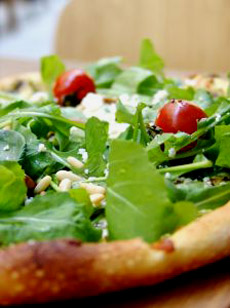 ham and green peppers—not exactly the duck sausage with leeks and spinach, goat cheese and Black Forest ham, caviar and smoked salmon, and artichoke and wild mushroom pizzas re-defined by Wolfgang Puck at his trend-setting West Hollywood restaurant Spago in the early 1980s. Most of 3 billion pizzas are sold annually in the U.S. are at the opposite end of the scale: Pizza Hut controls 17% of the pizza industry’s market share, Domino’s is second with 10% and Papa John’s is third with 6%. There are numerous official “Pizza Days” in the U.S.: September 5 is National Cheese Pizza Day, October 11 is National Sausage Pizza Day, November 12 is National Pizza with the Works Except Anchovies Day, and February 9 is International Pizza Day. October has been declared National Pizza Month (because it’s Christopher Columbus’s birth month). Who declares these food holidays? There actually is an official process. For more information and more food holidays than you can dream of, see our section on American Food Holidays. ham and green peppers—not exactly the duck sausage with leeks and spinach, goat cheese and Black Forest ham, caviar and smoked salmon, and artichoke and wild mushroom pizzas re-defined by Wolfgang Puck at his trend-setting West Hollywood restaurant Spago in the early 1980s. Most of 3 billion pizzas are sold annually in the U.S. are at the opposite end of the scale: Pizza Hut controls 17% of the pizza industry’s market share, Domino’s is second with 10% and Papa John’s is third with 6%. There are numerous official “Pizza Days” in the U.S.: September 5 is National Cheese Pizza Day, October 11 is National Sausage Pizza Day, November 12 is National Pizza with the Works Except Anchovies Day, and February 9 is International Pizza Day. October has been declared National Pizza Month (because it’s Christopher Columbus’s birth month). Who declares these food holidays? There actually is an official process. For more information and more food holidays than you can dream of, see our section on American Food Holidays.
Above: Gourmet pizza with goat cheese, topped with fresh arugula, pine nuts and cherry tomatoes. Wolfgang would be proud. Photo by Ugur Vidinligil.
Healthy Dining. If you need something healthier than arugula pizza, the National Restaurant Association is getting ready to help. Anxious to show that you can eat healthy while dining out, the National Restaurant Association is building a website that will list healthy meals, as well as eateries across the country where they can be found. The database isn’t yet populated, but if you want to see the prototype at HealthyDining.com. We’ll report back when the database is ready to go.
Personal Chefs—The Growing Field. If you want to eat healthier at home—or just eat better in general—how about retaining a personal chef? That’s what Food Network star  Giada de Laurentiis was when she was tapped for her first on-air cooking show tryout. The personal chef industry is a relatively young one but rapidly growing. It is a separate career from a restaurant chef and has its own trade association, the United States Personal Chef Association, which says that the $100 million industry is expected to grow to about $150 million in five years. Many personal chefs leave jobs in restaurants as well as non-food jobs pursue their love of cooking— and working for themselves. While the rich and famous have full-time chefs, most personal chefs have many private clients. The chefs generally prepare food on their own premises and then deliver it to the clients, who are not limited to high-earners. Busy working families are hiring personal chefs as their disposable income grows. Often, the expense is no more than costly take-out food or eating out several nights a week. Yet the food is much healthier, the temptations to order “bad” things from the menu are avoided, and personal chefs can tailor meals that cater to clients’ specific dietary needs—low fat, sugar free, nut-free, et al. Many personal chefs can prepare five delicious dinners, four servings for about $375, or $75 a dinner. Some families spend close to that on food, tax and tips for more ordinary fare. Meals are put in the client’s freezer, ready to pop into the oven. You can find a personal chef at The United States Personal Chef Association, HireAChef.com. Giada de Laurentiis was when she was tapped for her first on-air cooking show tryout. The personal chef industry is a relatively young one but rapidly growing. It is a separate career from a restaurant chef and has its own trade association, the United States Personal Chef Association, which says that the $100 million industry is expected to grow to about $150 million in five years. Many personal chefs leave jobs in restaurants as well as non-food jobs pursue their love of cooking— and working for themselves. While the rich and famous have full-time chefs, most personal chefs have many private clients. The chefs generally prepare food on their own premises and then deliver it to the clients, who are not limited to high-earners. Busy working families are hiring personal chefs as their disposable income grows. Often, the expense is no more than costly take-out food or eating out several nights a week. Yet the food is much healthier, the temptations to order “bad” things from the menu are avoided, and personal chefs can tailor meals that cater to clients’ specific dietary needs—low fat, sugar free, nut-free, et al. Many personal chefs can prepare five delicious dinners, four servings for about $375, or $75 a dinner. Some families spend close to that on food, tax and tips for more ordinary fare. Meals are put in the client’s freezer, ready to pop into the oven. You can find a personal chef at The United States Personal Chef Association, HireAChef.com.
Product Watch
Frozen Baby Cubes. Frozen organic vegetable and fruit cubes from Baby Cubes & More, Inc. can now be purchased online at www.mynami.com. Each bag contains ten 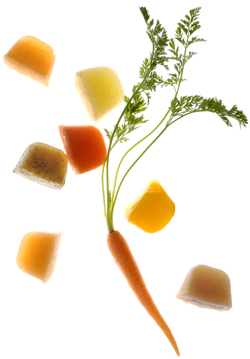 one-ounce servings of an organic fruit or vegetable, frozen into ice-cube sizes for easy preparation and mixing into tasty, easy-to-prepare, nutritious foods. Fresh seasonal produce is puréed, poured into cube molds and blast-chilled to lock in the nutrients, flavor, texture and color. The small serving size lets the baby decide how much he or she wants to eat. The menu of veggies includes asparagus, beets, broccoli, carrots, peas, rutabaga, spinach, summer squash, sweet potatoes and winter squash. Fruits include apple, apricot, blueberry, cantaloupe, honeydew, mango, nectarine, papaya, peach, pear and plum. The products stay freezer-fresh (is that an oxymoron?) for up to six months. Development is underway for new products targeted to older babies and toddlers. Expansion into retail stores is slated for early next year. one-ounce servings of an organic fruit or vegetable, frozen into ice-cube sizes for easy preparation and mixing into tasty, easy-to-prepare, nutritious foods. Fresh seasonal produce is puréed, poured into cube molds and blast-chilled to lock in the nutrients, flavor, texture and color. The small serving size lets the baby decide how much he or she wants to eat. The menu of veggies includes asparagus, beets, broccoli, carrots, peas, rutabaga, spinach, summer squash, sweet potatoes and winter squash. Fruits include apple, apricot, blueberry, cantaloupe, honeydew, mango, nectarine, papaya, peach, pear and plum. The products stay freezer-fresh (is that an oxymoron?) for up to six months. Development is underway for new products targeted to older babies and toddlers. Expansion into retail stores is slated for early next year.
Hershey’s Competes With Prestige Chocolatiers. The same company that sells 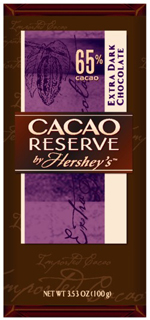 the country’s most famous newsstand chocolate bar is launching gourmet chocolate that sounds similar to the products offered by finest chocolatiers in the world—including Scharffenberger, the great American chocolate house it purchased earlier this year. The Cacao Reserve by Hershey’s line launches with all-natural, premium 35% and 65% cacao bars, some with nuts and nibs. In December, the line will expand to include single origin bars: a 32% bar from Java, a 50% Arriba bar, a 67% Santo Domingo bar and a 70% São Tomé bar. As we’ve written in our articles on how to evaluate chocolate, the percentage of the cacao is just an indicator of intensity, like the proof of alcohol, and has no bearing on the quality of the product. A 70% cacao bar made from mediocre beans is mediocre chocolate; a 60% bar made from good beans is good chocolate. Other pieces in the line will include cocoa in Classic Mayan and Mildly Spiced Aztec; and milk and dark truffles. We’ve tasted the first four bars, and they are delicious! Watch for our review next month. We We look forward to tasting the rest of the line and reporting back. the country’s most famous newsstand chocolate bar is launching gourmet chocolate that sounds similar to the products offered by finest chocolatiers in the world—including Scharffenberger, the great American chocolate house it purchased earlier this year. The Cacao Reserve by Hershey’s line launches with all-natural, premium 35% and 65% cacao bars, some with nuts and nibs. In December, the line will expand to include single origin bars: a 32% bar from Java, a 50% Arriba bar, a 67% Santo Domingo bar and a 70% São Tomé bar. As we’ve written in our articles on how to evaluate chocolate, the percentage of the cacao is just an indicator of intensity, like the proof of alcohol, and has no bearing on the quality of the product. A 70% cacao bar made from mediocre beans is mediocre chocolate; a 60% bar made from good beans is good chocolate. Other pieces in the line will include cocoa in Classic Mayan and Mildly Spiced Aztec; and milk and dark truffles. We’ve tasted the first four bars, and they are delicious! Watch for our review next month. We We look forward to tasting the rest of the line and reporting back.

9.4.06
White Grapes May Be As Heart-Healthy As Red. According to a laboratory study by Italian and U.S. researchers, the flesh of grapes is just as heart-healthy as the skin, 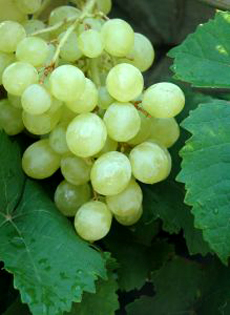
with the implication that white grapes and white wine have as many antioxidants as red. Testing the cardioprotective effects of four varieties of grape skin and grape flesh extracts on rats, scientists found that the flesh extract was just as protective as the skin extract. The basis for prior studies is the observation that the skin of red grapes is a rich source of anthocyanins, potent antioxidants that contribute to the red color of the fruit. Red grapes are usually crushed whole, meaning that the anthocyanins are transferred to the juice and the resulting wine. To make most white wine or white grape juices, however, the skins are first separated from the flesh. This practice led to the conventional belief that red wine and red grape juice are healthier for the heart than white. The new study, published on-line ahead of print in the Journal of Agricultural and Food Chemistry, challenges this view by reporting that both skin and flesh have cardioprotective potential, despite vastly differing polyphenol content. “The results indicate for the first time that the flesh of grapes is equally cardioprotective as skin, and the antioxidant potential of skin and flesh of grapes are comparable with each other despite of the fact that flesh does not possess any anthocyanin activities,” wrote the researchers.
Product Watch
Canned Avocados: Coming To A Store Near You. So firm, so green, so...canned? A new technique has been developed by food engineers in Argentina to can avocados while retaining their nutrients. Preserving the fruit without freezing will allow 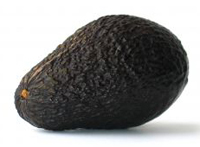 processors to export the nutrient-rich product to foreign markets where demand is on the rise. In France alone, per capita consumption went from 400 to 1500 grams (.8 to 3.3 pounds) in the last year, according to Research and Markets. The technique coats the avocado and treats it with an antioxidant. The process can increase shelf life of pasteurized avocado pulp and dry avocado powder to at least six months. Freezing, the typical preservation technique, gives avocados a longer shelf life, but has a negative effect on the fruit’s nutritional value, said engineers Diego Prieto and Martin Cecchini in Science Live magazine. If the canned avocado tastes as good as the fresh-ripened, it can mean guacamole-on-call for all of us who patiently wait for our fruits to ripen. processors to export the nutrient-rich product to foreign markets where demand is on the rise. In France alone, per capita consumption went from 400 to 1500 grams (.8 to 3.3 pounds) in the last year, according to Research and Markets. The technique coats the avocado and treats it with an antioxidant. The process can increase shelf life of pasteurized avocado pulp and dry avocado powder to at least six months. Freezing, the typical preservation technique, gives avocados a longer shelf life, but has a negative effect on the fruit’s nutritional value, said engineers Diego Prieto and Martin Cecchini in Science Live magazine. If the canned avocado tastes as good as the fresh-ripened, it can mean guacamole-on-call for all of us who patiently wait for our fruits to ripen.
Breyers® Goes Organic. Breyers has launched a USDA-certified organic ice cream to meet growing 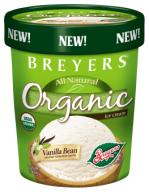 consumer demand for organic foods. Breyers Organic Ice Cream will be offered in Vanilla Bean, Chocolate, Coffee and Vanilla Fudge Swirl flavors. Quarts will be available nationwide beginning this September at a suggested retail price of $4.99 to $5.99. According to the Organic Trade Association, organic food sales have nearly tripled since 1997, growing between 17 and 21 percent annually. In the same period the organic ice cream segment has grown nearly 55 percent. Breyers also offers Lactose Free Vanilla ice cream, for the 30 to 50 million consumers nationwide who are lactose intolerant; and a line of No Sugar Added ice creams, which have been reviewed by THE NIBBLE™. Breyers is manufactured by Unilever North American Ice Cream, the largest manufacturer and marketer of branded packaged ice cream and frozen novelties in the United States. The company also produces Ben & Jerry’s®, Good Humor®, Klondike® and Popsicle® brands. consumer demand for organic foods. Breyers Organic Ice Cream will be offered in Vanilla Bean, Chocolate, Coffee and Vanilla Fudge Swirl flavors. Quarts will be available nationwide beginning this September at a suggested retail price of $4.99 to $5.99. According to the Organic Trade Association, organic food sales have nearly tripled since 1997, growing between 17 and 21 percent annually. In the same period the organic ice cream segment has grown nearly 55 percent. Breyers also offers Lactose Free Vanilla ice cream, for the 30 to 50 million consumers nationwide who are lactose intolerant; and a line of No Sugar Added ice creams, which have been reviewed by THE NIBBLE™. Breyers is manufactured by Unilever North American Ice Cream, the largest manufacturer and marketer of branded packaged ice cream and frozen novelties in the United States. The company also produces Ben & Jerry’s®, Good Humor®, Klondike® and Popsicle® brands.
September Food Events
New York City: Illy Coffee Events. Following the success of last year’s fun and educational “28 Seconds” program (28 seconds is the amount of time it takes to brew 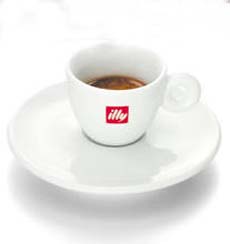 the perfect cup of espresso), Illy is back with more tasty and informational coffee events, held throughout the glamorous Time Warner Center in Columbus Circle. Coffee Sense, on Tuesdays, is an interactive tasting session that explains how to distinguish the different flavor notes in coffee. It’s held on September 12 (6:30p.m. to 7:30p.m.), September 19 (1:00p.m. to 2:00p.m.), September 26 (6:30p.m. to 7:30p.m.) and October 3, 2006 (5:30p.m. to 6:30p.m.). The month of events incorporates an art exhibit, a book launch (September 14) and an evening with artist James Rosenquist (September 28). It concludes with a celebration of the paperback launch of the New York Times best-seller, Hidden Kitchens, with readings by Joan Allen and Kim Severson and special guest Myra Alperson, founder of “Noshwalk,” October 1, 11:30 a.m. to 12:30 p.m. For a complete schedule of events, visit IllyUSA.com. the perfect cup of espresso), Illy is back with more tasty and informational coffee events, held throughout the glamorous Time Warner Center in Columbus Circle. Coffee Sense, on Tuesdays, is an interactive tasting session that explains how to distinguish the different flavor notes in coffee. It’s held on September 12 (6:30p.m. to 7:30p.m.), September 19 (1:00p.m. to 2:00p.m.), September 26 (6:30p.m. to 7:30p.m.) and October 3, 2006 (5:30p.m. to 6:30p.m.). The month of events incorporates an art exhibit, a book launch (September 14) and an evening with artist James Rosenquist (September 28). It concludes with a celebration of the paperback launch of the New York Times best-seller, Hidden Kitchens, with readings by Joan Allen and Kim Severson and special guest Myra Alperson, founder of “Noshwalk,” October 1, 11:30 a.m. to 12:30 p.m. For a complete schedule of events, visit IllyUSA.com.
Londonderry, Vermont: Autumn Leaves Cheese Festival. A celebration of traditional cheesemaking and handmade products from more than 30 small farms and specialty food producers in the Northeast. Watch cheesemaking, participate in structured tastings and enjoy family activities like hay rides. For more information, go to www.artisanmade-ne.com, or telephone 1.203.264.2883. Saturday, September 30 from 10 a.m. to 4 p.m. at Taylor Farm in Londonderry.
News Archives
| 3rd Quarter 2006 |
|
|
|
|
|
| 2nd Quarter 2006 |
1st Quarter 2006 |
4th Quarter 2005 |
|
|
|
| 3rd Quarter 2005 |
2nd Quarter 2005 |
1st Quarter 2005 |
|
|
|
Send your product news to:
Info - at - TheNibble.com.
Substitute @ for -at-. We use this convention to avoid address-harvesting spam spiders.
Lifestyle Direct Direct, Inc. All rights reserved. Images are the copyright of their respective owners.

|






 Product Watch
Product Watch  Vineyards that practice biodynamic agriculture include Ceago, Cooper Mountain, Frey and Patianna. Their wines are available now in all Wild Oats stores that have liquor licenses. Biodynamic agriculture dates back to 1924, is considered the oldest comprehensive method of farming and is practiced around the world. A more rigorous process than organic farming, it sustains soil productivity and maintains biodiversity with the use of organic pest controls, crop rotation and the cyclical rhythms of nature. Practitioners attest that biodynamic agriculture results in a greener planet, self-sustaining farms, healthier soil, and great-tasting food and wines that are rich in nutrients. In order for a product to be labeled as Biodynamic, it must comply with strict standards set by Demeter USA (demeter-usa.org). Biodynamic® is a registered trademark held by Demeter Association Inc. (see certification seal above) and is globally recognized as a symbol for products grown using approved Biodynamic methods. Read our complete article on
Vineyards that practice biodynamic agriculture include Ceago, Cooper Mountain, Frey and Patianna. Their wines are available now in all Wild Oats stores that have liquor licenses. Biodynamic agriculture dates back to 1924, is considered the oldest comprehensive method of farming and is practiced around the world. A more rigorous process than organic farming, it sustains soil productivity and maintains biodiversity with the use of organic pest controls, crop rotation and the cyclical rhythms of nature. Practitioners attest that biodynamic agriculture results in a greener planet, self-sustaining farms, healthier soil, and great-tasting food and wines that are rich in nutrients. In order for a product to be labeled as Biodynamic, it must comply with strict standards set by Demeter USA (demeter-usa.org). Biodynamic® is a registered trademark held by Demeter Association Inc. (see certification seal above) and is globally recognized as a symbol for products grown using approved Biodynamic methods. Read our complete article on  are packaged in pyramid-shaped, gossamer tea bags, similar to those that have been used for several years by specialty tea producers. Launching with Vanilla Caramel Truffle, Island Mango and Bavarian Wild Berry mixed with black, white, green and red teas, each flavor of Lipton® Pyramid Teas blends long leaf tea, real pieces of fruit, herbs and other natural flavors. Lipton® Pyramid Teas are available nationwide with a suggested retail price of $3.49 for a 20-count box, higher than Twinings and other premium-priced supermarket teas (that are not in fancy bags), but less than specialty store brands. It is the first premium tea of its kind offered in mass-market retail and grocery stores. While the company is marketing the product as “revolutionary,” the revolution was begun five years ago by specialty tea producers like Mighty Leaf and Tea Forte (and numerous other since), which have been producing a similar-shaped bag and loose leaf tea blends (below, Tea Forte’s pyramid-shaped tea bag). However, given its mammoth size, Lipton is in a position to sell more Pyramid Tea bags than the entire specialty food industry. This gives way to the second point: long leaf tea doesn’t mean top quality tea, any more than 70% cacao chocolate means great chocolate, a point we’ve previously noted in this column. The finest leaves come from very small estates that could never supply enough tea to meet the need of a mass marketer like Lipton. Still, the tea is a step up from the regular Lipton bag tea—at a step up in price, as well.
are packaged in pyramid-shaped, gossamer tea bags, similar to those that have been used for several years by specialty tea producers. Launching with Vanilla Caramel Truffle, Island Mango and Bavarian Wild Berry mixed with black, white, green and red teas, each flavor of Lipton® Pyramid Teas blends long leaf tea, real pieces of fruit, herbs and other natural flavors. Lipton® Pyramid Teas are available nationwide with a suggested retail price of $3.49 for a 20-count box, higher than Twinings and other premium-priced supermarket teas (that are not in fancy bags), but less than specialty store brands. It is the first premium tea of its kind offered in mass-market retail and grocery stores. While the company is marketing the product as “revolutionary,” the revolution was begun five years ago by specialty tea producers like Mighty Leaf and Tea Forte (and numerous other since), which have been producing a similar-shaped bag and loose leaf tea blends (below, Tea Forte’s pyramid-shaped tea bag). However, given its mammoth size, Lipton is in a position to sell more Pyramid Tea bags than the entire specialty food industry. This gives way to the second point: long leaf tea doesn’t mean top quality tea, any more than 70% cacao chocolate means great chocolate, a point we’ve previously noted in this column. The finest leaves come from very small estates that could never supply enough tea to meet the need of a mass marketer like Lipton. Still, the tea is a step up from the regular Lipton bag tea—at a step up in price, as well.

 box. Borrowing a good idea from milk and juice boxes, these portion-controlled and portable formats combine form and function in attractive packaging. And they can go places that smaller glass bottles can’t—to the beach and the golf course, for example. While Diamond Creek and Chalone won’t be boxing their wines anytime soon, popular-priced winemakers, recognizing a growing demand by consumers for convenience. More mini bottles, cans and, most recently, juice-boxlike pouches that hold a single serving of wine are making it onto the shelves of supermarkets and other retailers. The pouches typically hold the contents of a glass (187 ml) or a glass and a half (250 ml) and are sold in four-packs. Inexpensive wines like Sutter Home and the colorfully-named Three Bandits, a sister company that sells its products only in jug, box or pouch, are at the forefront. Even Target has a chic designed version called the Cube. A four-pack costs typically costs $8 to $10. According to market research firm ACNielsen, sales of single-serving wines in 187-ml containers grew 14.7%, or $13 million, in the past year, pulling in nearly $100 million for the industry. During the same period, sales of standard-size 750-ml bottles grew 12%, and overall wine sales, 9%. As the single-serve format gains traction, the quality of single-serve wine eventually will improve—and perhaps a straw will be included, so there’s no need for a glass?
box. Borrowing a good idea from milk and juice boxes, these portion-controlled and portable formats combine form and function in attractive packaging. And they can go places that smaller glass bottles can’t—to the beach and the golf course, for example. While Diamond Creek and Chalone won’t be boxing their wines anytime soon, popular-priced winemakers, recognizing a growing demand by consumers for convenience. More mini bottles, cans and, most recently, juice-boxlike pouches that hold a single serving of wine are making it onto the shelves of supermarkets and other retailers. The pouches typically hold the contents of a glass (187 ml) or a glass and a half (250 ml) and are sold in four-packs. Inexpensive wines like Sutter Home and the colorfully-named Three Bandits, a sister company that sells its products only in jug, box or pouch, are at the forefront. Even Target has a chic designed version called the Cube. A four-pack costs typically costs $8 to $10. According to market research firm ACNielsen, sales of single-serving wines in 187-ml containers grew 14.7%, or $13 million, in the past year, pulling in nearly $100 million for the industry. During the same period, sales of standard-size 750-ml bottles grew 12%, and overall wine sales, 9%. As the single-serve format gains traction, the quality of single-serve wine eventually will improve—and perhaps a straw will be included, so there’s no need for a glass?  from around the world. (The package announces one must be of legal age to buy the sorbet, and in fact, the register scan told the cashier to verify our age!) Seven “current vintages” include three reds (a 2005 Cabernet Sauvignon from California, a 2004 Red Zinfandel from California, and a 2005 Pinot Noir from New York), three whites (a 2004 Riesling from New York, a non-vintage Sauternes from New York and a non-vintage Champagne from California), and one blush wine, a non-vintage May Wine from New York. The flavors will change on a rotating basis. Unlike most sorbets, these are not particularly sweet, but are serious gourmet products that make excellent palate cleansers between courses as well as sophisticated desserts. We would serve them with cheese. They also can be incorporated into frozen cocktails. Like most sorbets, they are low in sugar and have with no fat. They’re currently available in New York and New Jersey at Whole Foods Markets and specialty food stores, priced at $4.99 to $6.99 per pint. National distribution is planned. Check the store locator at WineCellarSorbets.com.
from around the world. (The package announces one must be of legal age to buy the sorbet, and in fact, the register scan told the cashier to verify our age!) Seven “current vintages” include three reds (a 2005 Cabernet Sauvignon from California, a 2004 Red Zinfandel from California, and a 2005 Pinot Noir from New York), three whites (a 2004 Riesling from New York, a non-vintage Sauternes from New York and a non-vintage Champagne from California), and one blush wine, a non-vintage May Wine from New York. The flavors will change on a rotating basis. Unlike most sorbets, these are not particularly sweet, but are serious gourmet products that make excellent palate cleansers between courses as well as sophisticated desserts. We would serve them with cheese. They also can be incorporated into frozen cocktails. Like most sorbets, they are low in sugar and have with no fat. They’re currently available in New York and New Jersey at Whole Foods Markets and specialty food stores, priced at $4.99 to $6.99 per pint. National distribution is planned. Check the store locator at WineCellarSorbets.com.  bar, even the gum. While other specialty juice companies were quick to “go pomegranate,” juice giant Tropicana® launched a pomegranate-blueberry juice in July. Native to the Middle East, the pomegranate is full of vitamins A, C and E and high in folic acid and polyphenol antioxidants. A study released by UCLA in June indicates that drinking a glass of pomegranate juice a day can help slow the spread of prostate cancer. The study also explains that, unlike drinking most fruit juices, drinking pomegranate juice is more healthful than eating the fruit itself because 70% of the antioxidants are released from the peel when the pomegranate is squeezed. (We’re not sure how healthy it is when we’re packing away a pint of our favorite product, the pomegranate ice cream with chocolate chips from Sheer Bliss).
bar, even the gum. While other specialty juice companies were quick to “go pomegranate,” juice giant Tropicana® launched a pomegranate-blueberry juice in July. Native to the Middle East, the pomegranate is full of vitamins A, C and E and high in folic acid and polyphenol antioxidants. A study released by UCLA in June indicates that drinking a glass of pomegranate juice a day can help slow the spread of prostate cancer. The study also explains that, unlike drinking most fruit juices, drinking pomegranate juice is more healthful than eating the fruit itself because 70% of the antioxidants are released from the peel when the pomegranate is squeezed. (We’re not sure how healthy it is when we’re packing away a pint of our favorite product, the pomegranate ice cream with chocolate chips from Sheer Bliss).  produces barley tea bags for a Japanese company, and will debut its American brand in a few months. Barley tea is made from grain, not tea leaves. It has an exotic roasted flavor: the grains are roasted as if they were coffee beans, then ground like coffee. In fact, the product tastes a bit like coffee, and can be drunk black or sweetened. Barley tea is naturally caffeine-free, high in fiber and contains antioxidants. In Japan, the tea is drunk hot or iced, and is as ubiquitous as soda, sold in vending machines and convenience stores. In America, according to the National Barley Foods Council, more than half of the nearly 320 million bushels of barley produced in the U.S. each year are used for animal feed. About 44% is used to produce malt, the key ingredient in another favorite beverage, beer. Only 2% is used in food products. However, as Americans seem to respond well to each new healthy food with a promise that hits the market, that number could grow. The U.S. Food and Drug Administration has approved the Council’s claim that barley can reduce the risk of coronary disease. Barley contains beta glucan, a fiber-type complex sugar that can help lower cholesterol. It remains for the tea-producers to prove how much cholesterol-lowering beta glucan remains in the barley after roasting. Barley tea can currently be found in Asian products stores and health food stores.
produces barley tea bags for a Japanese company, and will debut its American brand in a few months. Barley tea is made from grain, not tea leaves. It has an exotic roasted flavor: the grains are roasted as if they were coffee beans, then ground like coffee. In fact, the product tastes a bit like coffee, and can be drunk black or sweetened. Barley tea is naturally caffeine-free, high in fiber and contains antioxidants. In Japan, the tea is drunk hot or iced, and is as ubiquitous as soda, sold in vending machines and convenience stores. In America, according to the National Barley Foods Council, more than half of the nearly 320 million bushels of barley produced in the U.S. each year are used for animal feed. About 44% is used to produce malt, the key ingredient in another favorite beverage, beer. Only 2% is used in food products. However, as Americans seem to respond well to each new healthy food with a promise that hits the market, that number could grow. The U.S. Food and Drug Administration has approved the Council’s claim that barley can reduce the risk of coronary disease. Barley contains beta glucan, a fiber-type complex sugar that can help lower cholesterol. It remains for the tea-producers to prove how much cholesterol-lowering beta glucan remains in the barley after roasting. Barley tea can currently be found in Asian products stores and health food stores.  Diet Delight: SPLENDA® Flavor Blends For Coffee. More than 80% of Americans drink coffee daily¹, with flavors, like hazelnut, representing 30% of all specialty coffee sales². Combining flavors with its no-calorie sweetener, McNeil Nutritionals, makers of SPLENDA® Sweeteners, has launched SPLENDA® Flavor Blends for Coffee. Made specifically for hot coffee, the flavored sweetener is available in French Vanilla, Hazelnut and Mocha. The product is available at supermarkets nationwide and can be found in the coffee aisle. In November, SPLENDA® will launch another new product: SPLENDA® Cafe Sticks, previously available only in fine restaurants, will be available for at-home purchase. It’s the same sweetener as in the original flat yellow packages, but more upscale packaging. For more information, visit SPLENDA.com.
Diet Delight: SPLENDA® Flavor Blends For Coffee. More than 80% of Americans drink coffee daily¹, with flavors, like hazelnut, representing 30% of all specialty coffee sales². Combining flavors with its no-calorie sweetener, McNeil Nutritionals, makers of SPLENDA® Sweeteners, has launched SPLENDA® Flavor Blends for Coffee. Made specifically for hot coffee, the flavored sweetener is available in French Vanilla, Hazelnut and Mocha. The product is available at supermarkets nationwide and can be found in the coffee aisle. In November, SPLENDA® will launch another new product: SPLENDA® Cafe Sticks, previously available only in fine restaurants, will be available for at-home purchase. It’s the same sweetener as in the original flat yellow packages, but more upscale packaging. For more information, visit SPLENDA.com.

 ham and green peppers—not exactly the duck sausage with leeks and spinach, goat cheese and Black Forest ham, caviar and smoked salmon, and artichoke and wild mushroom pizzas re-defined by Wolfgang Puck at his trend-setting West Hollywood restaurant Spago in the early 1980s. Most of 3 billion pizzas are sold annually in the U.S. are at the opposite end of the scale: Pizza Hut controls 17% of the pizza industry’s market share, Domino’s is second with 10% and Papa John’s is third with 6%. There are numerous official “Pizza Days” in the U.S.: September 5 is National Cheese Pizza Day, October 11 is National Sausage Pizza Day, November 12 is National Pizza with the Works Except Anchovies Day, and February 9 is International Pizza Day. October has been declared National Pizza Month (because it’s Christopher Columbus’s birth month). Who declares these food holidays? There actually is an official process. For more information and more food holidays than you can dream of, see our section on
ham and green peppers—not exactly the duck sausage with leeks and spinach, goat cheese and Black Forest ham, caviar and smoked salmon, and artichoke and wild mushroom pizzas re-defined by Wolfgang Puck at his trend-setting West Hollywood restaurant Spago in the early 1980s. Most of 3 billion pizzas are sold annually in the U.S. are at the opposite end of the scale: Pizza Hut controls 17% of the pizza industry’s market share, Domino’s is second with 10% and Papa John’s is third with 6%. There are numerous official “Pizza Days” in the U.S.: September 5 is National Cheese Pizza Day, October 11 is National Sausage Pizza Day, November 12 is National Pizza with the Works Except Anchovies Day, and February 9 is International Pizza Day. October has been declared National Pizza Month (because it’s Christopher Columbus’s birth month). Who declares these food holidays? There actually is an official process. For more information and more food holidays than you can dream of, see our section on  Giada de Laurentiis was when she was tapped for her first on-air cooking show tryout. The personal chef industry is a relatively young one but rapidly growing. It is a separate career from a restaurant chef and has its own trade association, the United States Personal Chef Association, which says that the $100 million industry is expected to grow to about $150 million in five years. Many personal chefs leave jobs in restaurants as well as non-food jobs pursue their love of cooking— and working for themselves. While the rich and famous have full-time chefs, most personal chefs have many private clients. The chefs generally prepare food on their own premises and then deliver it to the clients, who are not limited to high-earners. Busy working families are hiring personal chefs as their disposable income grows. Often, the expense is no more than costly take-out food or eating out several nights a week. Yet the food is much healthier, the temptations to order “bad” things from the menu are avoided, and personal chefs can tailor meals that cater to clients’ specific dietary needs—low fat, sugar free, nut-free, et al. Many personal chefs can prepare five delicious dinners, four servings for about $375, or $75 a dinner. Some families spend close to that on food, tax and tips for more ordinary fare. Meals are put in the client’s freezer, ready to pop into the oven. You can find a personal chef at
Giada de Laurentiis was when she was tapped for her first on-air cooking show tryout. The personal chef industry is a relatively young one but rapidly growing. It is a separate career from a restaurant chef and has its own trade association, the United States Personal Chef Association, which says that the $100 million industry is expected to grow to about $150 million in five years. Many personal chefs leave jobs in restaurants as well as non-food jobs pursue their love of cooking— and working for themselves. While the rich and famous have full-time chefs, most personal chefs have many private clients. The chefs generally prepare food on their own premises and then deliver it to the clients, who are not limited to high-earners. Busy working families are hiring personal chefs as their disposable income grows. Often, the expense is no more than costly take-out food or eating out several nights a week. Yet the food is much healthier, the temptations to order “bad” things from the menu are avoided, and personal chefs can tailor meals that cater to clients’ specific dietary needs—low fat, sugar free, nut-free, et al. Many personal chefs can prepare five delicious dinners, four servings for about $375, or $75 a dinner. Some families spend close to that on food, tax and tips for more ordinary fare. Meals are put in the client’s freezer, ready to pop into the oven. You can find a personal chef at  one-ounce servings of an organic fruit or vegetable, frozen into ice-cube sizes for easy preparation and mixing into tasty, easy-to-prepare, nutritious foods. Fresh seasonal produce is puréed, poured into cube molds and blast-chilled to lock in the nutrients, flavor, texture and color. The small serving size lets the baby decide how much he or she wants to eat. The menu of veggies includes asparagus, beets, broccoli, carrots, peas, rutabaga, spinach, summer squash, sweet potatoes and winter squash. Fruits include apple, apricot, blueberry, cantaloupe, honeydew, mango, nectarine, papaya, peach, pear and plum. The products stay freezer-fresh (is that an oxymoron?) for up to six months. Development is underway for new products targeted to older babies and toddlers. Expansion into retail stores is slated for early next year.
one-ounce servings of an organic fruit or vegetable, frozen into ice-cube sizes for easy preparation and mixing into tasty, easy-to-prepare, nutritious foods. Fresh seasonal produce is puréed, poured into cube molds and blast-chilled to lock in the nutrients, flavor, texture and color. The small serving size lets the baby decide how much he or she wants to eat. The menu of veggies includes asparagus, beets, broccoli, carrots, peas, rutabaga, spinach, summer squash, sweet potatoes and winter squash. Fruits include apple, apricot, blueberry, cantaloupe, honeydew, mango, nectarine, papaya, peach, pear and plum. The products stay freezer-fresh (is that an oxymoron?) for up to six months. Development is underway for new products targeted to older babies and toddlers. Expansion into retail stores is slated for early next year.


 processors to export the nutrient-rich product to foreign markets where demand is on the rise. In France alone, per capita consumption went from 400 to 1500 grams (.8 to 3.3 pounds) in the last year, according to Research and Markets. The technique coats the avocado and treats it with an antioxidant. The process can increase shelf life of pasteurized avocado pulp and dry avocado powder to at least six months. Freezing, the typical preservation technique, gives avocados a longer shelf life, but has a negative effect on the fruit’s nutritional value, said engineers Diego Prieto and Martin Cecchini in Science Live magazine. If the canned avocado tastes as good as the fresh-ripened, it can mean guacamole-on-call for all of us who patiently wait for our fruits to ripen.
processors to export the nutrient-rich product to foreign markets where demand is on the rise. In France alone, per capita consumption went from 400 to 1500 grams (.8 to 3.3 pounds) in the last year, according to Research and Markets. The technique coats the avocado and treats it with an antioxidant. The process can increase shelf life of pasteurized avocado pulp and dry avocado powder to at least six months. Freezing, the typical preservation technique, gives avocados a longer shelf life, but has a negative effect on the fruit’s nutritional value, said engineers Diego Prieto and Martin Cecchini in Science Live magazine. If the canned avocado tastes as good as the fresh-ripened, it can mean guacamole-on-call for all of us who patiently wait for our fruits to ripen.  consumer demand for organic foods. Breyers Organic Ice Cream will be offered in Vanilla Bean, Chocolate, Coffee and Vanilla Fudge Swirl flavors. Quarts will be available nationwide beginning this September at a suggested retail price of $4.99 to $5.99. According to the Organic Trade Association, organic food sales have nearly tripled since 1997, growing between 17 and 21 percent annually. In the same period the organic ice cream segment has grown nearly 55 percent. Breyers also offers Lactose Free Vanilla ice cream, for the 30 to 50 million consumers nationwide who are lactose intolerant; and a line of
consumer demand for organic foods. Breyers Organic Ice Cream will be offered in Vanilla Bean, Chocolate, Coffee and Vanilla Fudge Swirl flavors. Quarts will be available nationwide beginning this September at a suggested retail price of $4.99 to $5.99. According to the Organic Trade Association, organic food sales have nearly tripled since 1997, growing between 17 and 21 percent annually. In the same period the organic ice cream segment has grown nearly 55 percent. Breyers also offers Lactose Free Vanilla ice cream, for the 30 to 50 million consumers nationwide who are lactose intolerant; and a line of  the perfect cup of espresso), Illy is back with more tasty and informational coffee events, held throughout the glamorous Time Warner Center in Columbus Circle. Coffee Sense, on Tuesdays, is an interactive tasting session that explains how to distinguish the different flavor notes in coffee. It’s held on September 12 (6:30p.m. to 7:30p.m.), September 19 (1:00p.m. to 2:00p.m.), September 26 (6:30p.m. to 7:30p.m.) and October 3, 2006 (5:30p.m. to 6:30p.m.). The month of events incorporates an art exhibit, a book launch (September 14) and an evening with artist James Rosenquist (September 28). It concludes with a celebration of the paperback launch of the New York Times best-seller, Hidden Kitchens, with readings by Joan Allen and Kim Severson and special guest Myra Alperson, founder of “Noshwalk,” October 1, 11:30 a.m. to 12:30 p.m. For a complete schedule of events, visit IllyUSA.com.
the perfect cup of espresso), Illy is back with more tasty and informational coffee events, held throughout the glamorous Time Warner Center in Columbus Circle. Coffee Sense, on Tuesdays, is an interactive tasting session that explains how to distinguish the different flavor notes in coffee. It’s held on September 12 (6:30p.m. to 7:30p.m.), September 19 (1:00p.m. to 2:00p.m.), September 26 (6:30p.m. to 7:30p.m.) and October 3, 2006 (5:30p.m. to 6:30p.m.). The month of events incorporates an art exhibit, a book launch (September 14) and an evening with artist James Rosenquist (September 28). It concludes with a celebration of the paperback launch of the New York Times best-seller, Hidden Kitchens, with readings by Joan Allen and Kim Severson and special guest Myra Alperson, founder of “Noshwalk,” October 1, 11:30 a.m. to 12:30 p.m. For a complete schedule of events, visit IllyUSA.com.